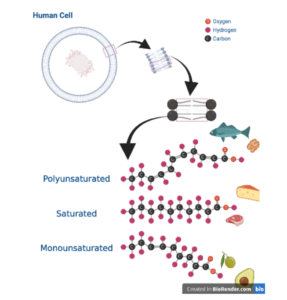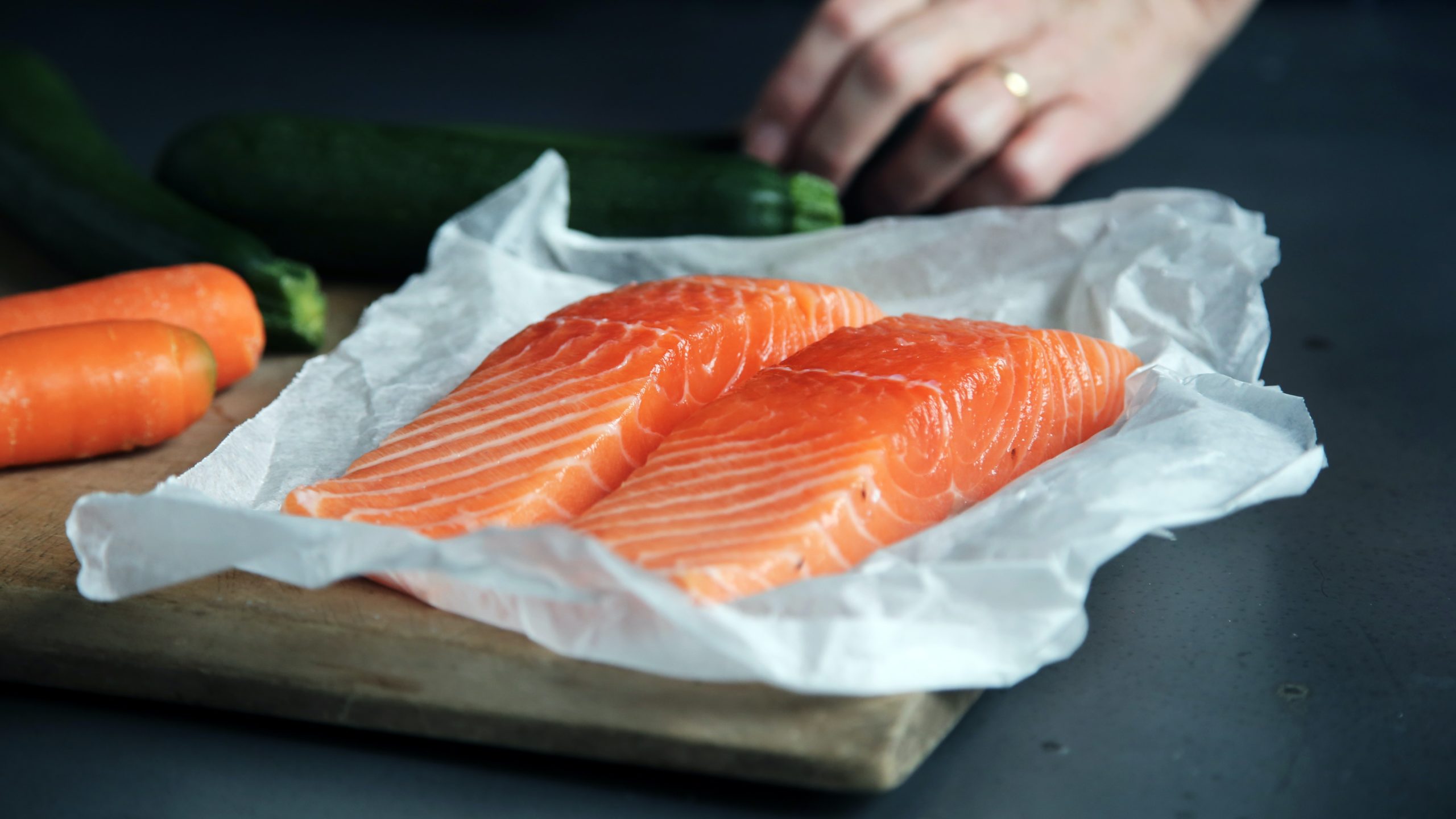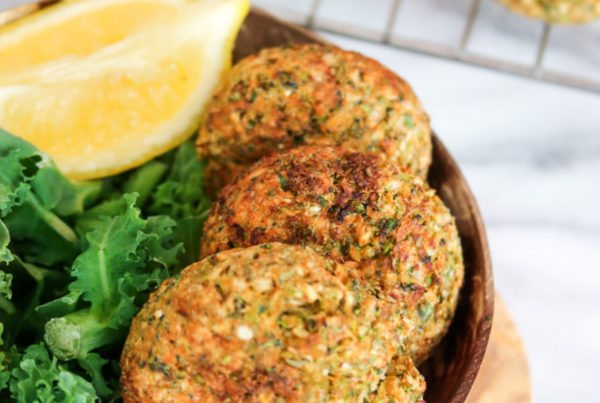In 1970, Denmark scientists discovered that the Inuit, Indigenous people of Greenland, have low triglyceride and “bad cholesterol” blood levels even though their diet is very high in long-chain Omega-3 fatty acids. Eskimos are also well-known for very rare occasions of coronary diseases and diabetes in their population. The scientists linked such disease resistance to the Inuit diet extremely rich in Eicosapentaenoic acid (EPA) and Docosahexaenoic acid (DHA) Omega-3 fatty acids. Only 45 years later, other researchers found out that the Inuit have a genetic mutation that allows them to control their fat metabolism. This adaption has been helping them consume lots of oily fish while having low blood cholesterol levels.
It might be surprising, but without this so-called Greenland paradox, we would probably still haven’t known anything about the importance of Omega-3 Fatty Acids for our health. So, let’s dive deeper into what we know today about Omega-3 Fatty acids!
Omega-3 Fatty Acids
Omega-3 Fatty Acids are essential to your body, one of the main building blocks of your cell membranes, and vital protectors against cardiovascular disease. This section will explore their structure and where they are found.
Definition and Examples of Fatty Acids
Omega-3 fatty acids are fats that belong to the polyunsaturated fatty acids (PUFA) family. But what exactly does it mean? As you already learned in our previous blog about fatty acids, there are two main groups of them: saturated and unsaturated. Unsaturated fatty acids can be divided further into mono- and polyunsaturated ones.
They all consist of the same chemical elements: carbon (C), hydrogen (H), and oxygen (O). However, their structure and physical properties significantly vary. For example, saturated fatty acids have no carbon-carbon double bond in their carbon chain, which makes them solid at room temperature. PUFA, on the other hand, can have multiple double bonds (that’s why poly!), which makes them liquid and less stable. They are also divided into two groups: Omega-3 and Omega-6 Fatty Acids. To understand fully the difference between various types of fatty acids and where they belong, look at these visuals:

This image shows the difference between the three main types of fatty acids and their food sources.
While monounsaturated fats can easily be created in our body from scratch, the situation with polyunsaturated fatty acids is much more complicated. Their two primary members, linoleic acid (Omega-6 fatty acid) and linolenic acid (Omega-3 fatty acid) are considered essential and must come from our diet. They have different functions, are found in distinct food sources, and can be converted further into other essential fatty acids in your body.
Three Main Omega-3 Fatty Acids, Their Food Sources, and Specifics
There are three main Omega-3 fatty acids. Linolenic acid specifically alpha-Linolenic acid (ALA), and her derivatives, EPA and DHA.
- Alpha-Linolenic Acid
It is a short-chain Omega-3 fatty acid that is primarily found in plant foods including leafy green vegetables such as collard, kale, and brussels sprouts. In addition to being essential building blocks for your cell membranes, one of its main functions is protecting you from heart and blood vessel disease. The 5-top food sources of ALA are flaxseed oil (7.4 g/15 ml), ground flax seeds (2.4 g/1 Tbsp), English walnuts (2.3 g/25 g), chia seeds (1.9 g/1 Tbsp), and soybeans (0.76 g/175 ml).
- Eicosapentaenoic acid (EPA) and Docosahexaenoic acid (DHA)
They are long-chain Omega-3 fatty acids that are essential for your brain function and vision. These fatty acids, in turn, are precursors for other compounds in your body called eicosanoids, hormone-like substances that affect your blood pressure, smooth muscle construction, blood clotting, and assist in immune response. When coming from EPA and DHA, they can dilate blood vessels and decrease blood pressure blood clotting, and inflammation. The 5-top foods rich in these Omega-3 fats are farmed salmon (1.7 g/75 g), wild salmon (1.3 g/75 g), canned sardines (0.7-1 g/75 g), mackerel (0.6-0.9 g/ 75 g) and halibut (0.2-0.9 g/75 g).
- Three Specifics of PUFA That You Should Know About
- Alpha-Linolenic Acid and Its LimitationsThis short-chain PUFA is primarily used as an energy source in your body. Only a very small amount of it can be converted into long-chain DHA and EPA fats directly. The degree of the conversion depends on the amount of other fatty acids consumed and is usually less than 15%. Thus, to ensure that you have all the benefits of DHA and EPA, consuming oily fish or DHA supplements if you are vegan or vegetarian regularly is important.
- Omega-3 : Omega-6 RatioResearch shows that controlling your dietary intake ratio of these PUFA is important to promote good health. The reason is that there is competition for the same enzymes in your body to convert their primary members to other vital components discussed above.
- Moderation Is a Key
Recommended Omega-3 and Omega-6 ratio intake is 17:1.6 g/day for males, and 12:1.1 g/day for females. Recall that EPA and DHA can dilate your blood vessels, so keep in mind that their overconsumption can lead to excessive bleeding. Some fish can also be a source of mercury and other contaminants. Although research shows that the benefits of EPA and DHA outweigh the risks, pregnant women, nursing mothers, and children should avoid fish that is high in mercury such as swordfish and tuna. Also remember, that only 30% of your daily energy intake should come from fats, wherein not less than 20% should be from unsaturated fatty acids.
What about supplements?
Various research has shown that taking Omega-3 fatty acids supplements does not lead to a decreased risk of cardiovascular disease and cancer. That being said, foods are the best sources of these essential fatty acids. Including oily fish, walnuts, and ground flaxseeds in your diet will help prevent heart disease and stroke as well as promote good health.
Reviewed by Annie Tsang, RD
References
Aung, T., Halsey, J., Kromhout, D., Gerstein, H. C., Marchioli, R., Tavazzi, L., Geleijnse, J. M., Rauch, B., Ness, A., Galan, P., Chew, E. Y., Bosch, J., Collins, R., Lewington, S., Armitage, J., & Clarke, R. (2018). Associations of omega-3 fatty acid supplement use with cardiovascular disease risks meta-analysis of 10 trials involving 77 917 individuals. JAMA Cardiology, 3(3). https://doi.org/10.1001/jamacardio.2017.5205
Bang, H. O., Dyerberg, J., & Hjørne, N. (1976). The Composition of Food Consumed by Greenland Eskimos. Acta Medica Scandinavica, 200(1–6), 69–73. https://doi.org/10.1111/j.0954-6820.1976.tb08198.x
Burdge, G. C., & Calder, P. C. (2005). Conversion of α-linolenic acid to longer-chain polyunsaturated fatty acids in human adults. In Reproduction Nutrition Development (Vol. 45, Issue 5, pp. 581–597). https://doi.org/10.1051/rnd:2005047
Djoussé, L., Pankow, J. S., Eckfeldt, J. H., Folsom, A. R., Hopkins, P. N., Province, M. A., Hong, Y., & Ellison, R. C. (2001). Relation between dietary linolenic acid and coronary artery disease in the National Heart, Lung, and Blood Institute Family Heart Study. American Journal of Clinical Nutrition, 74(5). https://doi.org/10.1093/ajcn/74.5.612
Fumagalli, M., Moltke, I., Grarup, N., Racimo, F., Bjerregaard, P., Jørgensen, M. E., Korneliussen, T. S., Gerbault, P., Skotte, L., Linneberg, A., Christensen, C., Brandslund, I., Jørgensen, T., Huerta-Sánchez, E., Schmidt, E. B., Pedersen, O., Hansen, T., Albrechtsen, A., & Nielsen, R. (2015). Greenlandic Inuit show genetic signatures of diet and climate adaptation. Science, 349(6254), 1343–1347. https://doi.org/10.1126/science.aab2319
Harvard T.H. Chan School of Public Health. (n.d.). Omega-3 Fatty Acids: An Essential Contribution. https://www.hsph.harvard.edu/nutritionsource/what-should-you-eat/fats-and-cholesterol/types-of-fat/omega-3-fats/#1
Leaf, A., Kang, J. X., Xiao, Y. F., & Billman, G. E. (2003). Clinical prevention of sudden cardiac death by n-3 polyunsaturated fatty acids and mechanism of prevention of arrhythmias by n-3 fish oils. In Circulation (Vol. 107, Issue 21). https://doi.org/10.1161/01.cir.0000069566.78305.33
Manson, J. E., Cook, N. R., Lee, I.-M., Christen, W., Bassuk, S. S., Mora, S., Gibson, H., Albert, C. M., Gordon, D., Copeland, T., D’Agostino, D., Friedenberg, G., Ridge, C., Bubes, V., Giovannucci, E. L., Willett, W. C., & Buring, J. E. (2019). Marine n−3 Fatty Acids and Prevention of Cardiovascular Disease and Cancer. New England Journal of Medicine, 380(1). https://doi.org/10.1056/nejmoa1811403
Mozaffarian, D., & Rimm, E. B. (2006). Fish Intake, Contaminants, and Human Health. JAMA, 296(15). https://doi.org/10.1001/jama.296.15.1885
National Institutes of Health Office of Dietary Supplements. (2022, July 18). Omega-3 Fatty Acids. Retrieved October 28, 2022, from https://ods.od.nih.gov/factsheets/Omega3FattyAcids-HealthProfessional/
Sanders, R. (2015, September 17). What the Inuit can tell us about omega-3 fats and ‘paleo’ diets. Retrieved October 28, 2022, from https://news.berkeley.edu/2015/09/17/what-the-inuit-can-tell-us-about-omega-3-fats-and-paleo-diets/
Sherratt, S. C. R., Juliano, R. A., Copland, C., Bhatt, D. L., Libby, P., & Mason, R. P. (2021). EPA and DHA containing phospholipids have contrasting effects on membrane structure. Journal of Lipid Research, 62. https://doi.org/10.1016/J.JLR.2021.100106
The Association of UK Dietitians. (n.d.). Omega-3: Food Fact Sheet. Retrieved October 28, 2022, from https://www.bda.uk.com/resource/omega-3.html
Whitney, E., Rolfes, S. R., Hammond, G., & Piche, L. A. (2016). Understanding Nutrition (2nd Canadian Edition). Lenore Taylor-Atkins.



